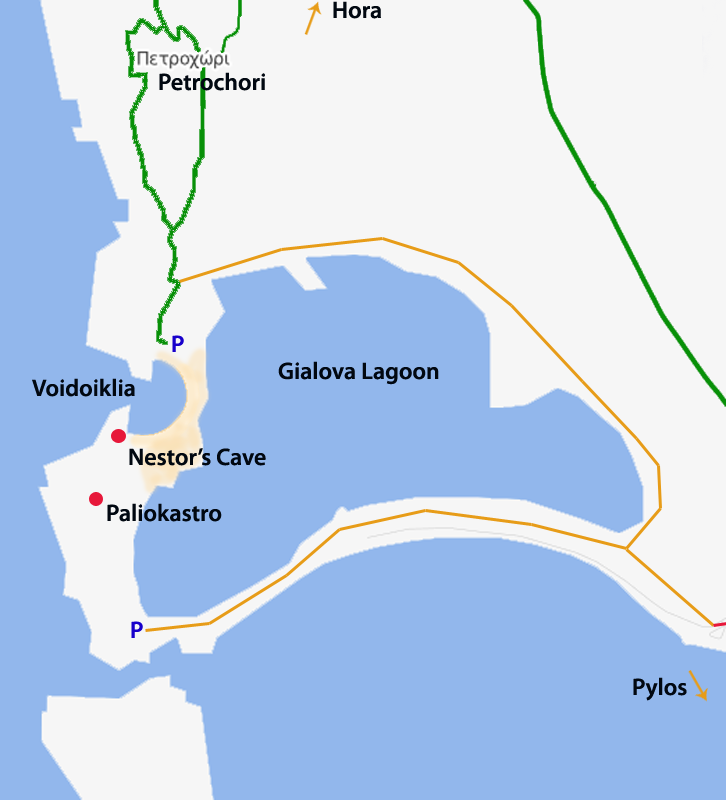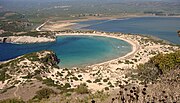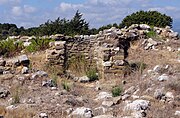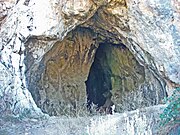| Revision as of 16:40, 20 September 2010 editFæ (talk | contribs)Extended confirmed users, Rollbackers83,148 edits →History and myth← Previous edit | Revision as of 16:44, 20 September 2010 edit undoFæ (talk | contribs)Extended confirmed users, Rollbackers83,148 edits ceNext edit → | ||
| Line 4: | Line 4: | ||
| ==History and myth== | ==History and myth== | ||
| Above the beach is ]'s Cave and above this are the ruins of a 13th century Frankish castle ("Palaiokastro").<ref name=Bostock2010 >{{citation | last=Bostock | first=Andrew | year=2010 | title=Greece: The Peloponnese | publisher=Bradt Travel Guides | isbn=9781841623078 | page=158 }}</ref> Overlooking the beach at the north eastern end is the tomb of Nestor's son, ] of the Mycenaean period (1680–1060 BC) with Neolithic finds at the same site showing occupation as early as 4,000 BC.<ref>Ministry of Culture on-site notice.</ref> | Above the beach is ]'s Cave and above this are the ruins of a 13th century Frankish castle ("Palaiokastro").<ref name=Bostock2010 >{{citation | last=Bostock | first=Andrew | year=2010 | title=Greece: The Peloponnese | publisher=Bradt Travel Guides | isbn=9781841623078 | page=158 }}</ref> Overlooking the beach at the north eastern end is the tomb of Nestor's son, ] of the Mycenaean period (1680–1060 BC) with Neolithic finds at the same site showing occupation as early as 4,000 BC.<ref>Ministry of Culture on-site notice.</ref> | ||
| The beach is presumed to be Homer's "sandy Pylos" where ] was welcomed by King Nestor when searching for his father, Odysseus. According to myth, Nestor's Cave is where Hermes hid the cattle stolen from Apollo.<ref name=Willett2004 >{{citation | last1=Willett | first1=David | year=2004 | title=Greece | last2=Bain | first2=Carolyn | last3=Clark | first3=Michael | last4=Hannigan | first4=Des | edition=6 | publisher=Lonely Planet | isbn=9781740594707 | page=189 }}</ref> | The beach is presumed to be Homer's "sandy Pylos" where ] was welcomed by King Nestor when searching for his father, Odysseus. According to myth, Nestor's Cave is where Hermes hid the cattle stolen from Apollo.<ref name=Willett2004 >{{citation | last1=Willett | first1=David | year=2004 | title=Greece | last2=Bain | first2=Carolyn | last3=Clark | first3=Michael | last4=Hannigan | first4=Des | edition=6 | publisher=Lonely Planet | isbn=9781740594707 | page=189 }}</ref> | ||
Revision as of 16:44, 20 September 2010

36°57′50″N 21°39′35″E / 36.963973399776386°N 21.659637093544006°E / 36.963973399776386; 21.659637093544006 Voidokilia Beach is a popular beach in Messinia in the Mediterranean area. In the shape of the Greek letter omega (Ω), its sand forms a semicircular strip of dunes. The land facing side of the strip of dunes is Gialova (or Yalova) Lagoon. The beach has been named "A Place of Particular Natural Beauty" and protected by natura 2000.
History and myth
Above the beach is Nestor's Cave and above this are the ruins of a 13th century Frankish castle ("Palaiokastro"). Overlooking the beach at the north eastern end is the tomb of Nestor's son, Thrasymedes of the Mycenaean period (1680–1060 BC) with Neolithic finds at the same site showing occupation as early as 4,000 BC.
The beach is presumed to be Homer's "sandy Pylos" where Telemachus was welcomed by King Nestor when searching for his father, Odysseus. According to myth, Nestor's Cave is where Hermes hid the cattle stolen from Apollo.
Location
A hiking route begins from Voidokoilia. The climb towards Nestor's Cave begins at the south-west end of the beach, while after the cave the route continues towards Palaiokastro. Voidokilia is next to Petrohori in Messinia, Greece.
Gialova's aquatic habitat, being an important stop for a variety of migratory birds, has been declared the southernmost Habitat of National Importance in the Balkans. It is considered a protected area hosting 258 species of birds out of which the 79 are included in the "Red Book" (species under threat of extinction).
Parking for the beach is reached by sand tracks either from the Gialova Lagoon parking area (also used by bird-watchers) or by following the Northside route from Petrochori. The beach is considered friendly for naturists and gay tourists.
Gallery
-
 View from Nestor's Cave looking down to the beach and the lagoon.
View from Nestor's Cave looking down to the beach and the lagoon.
-
 View from Thrasimidis' tomb.
View from Thrasimidis' tomb.
-
 Thrasimidis' tomb.
Thrasimidis' tomb.
-
 View of the castle and Nestor's cave from the beach.
View of the castle and Nestor's cave from the beach.
-
 Entrance to Nestor's cave.
Entrance to Nestor's cave.
-
 Naturism on the south end of the beach.
Naturism on the south end of the beach.
See also
Footnotes
- Bostock, Andrew (2010), Greece: The Peloponnese, Bradt Travel Guides, p. 158, ISBN 9781841623078
- Ministry of Culture on-site notice.
- Willett, David; Bain, Carolyn; Clark, Michael; Hannigan, Des (2004), Greece (6 ed.), Lonely Planet, p. 189, ISBN 9781740594707
- "Pylos M. / Excursion from Voidokiliabay to Palaiokastro hill". En.agrotravel.gr. 2008-07-14. Retrieved 2010-09-20.
- Deon Guide: 22, 2010 http://issuu.com/deonguide/docs/deoguide
{{citation}}: Missing or empty|title=(help)
External links
Category: